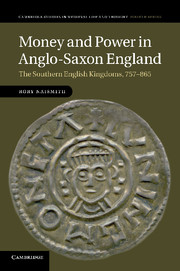Book contents
- Frontmatter
- Contents
- Figures
- Maps
- Tables
- Acknowledgements
- Abbreviations
- Chapter 1 Introduction
- Chapter 2 Money in its political context
- Chapter 3 Looking at coinage: iconography and inscriptions
- Chapter 4 Authority and minting I: the king
- Chapter 5 Authority and minting II: mints, die-cutters and moneyers
- Chapter 6 Value judgements: weight and fineness
- Chapter 7 Production of coinage
- Chapter 8 The circulation of coinage
- Chapter 9 The nature of coin-use in the early Middle Ages
- Chapter 10 Conclusion
- Bibliography
- Index
Chapter 10 - Conclusion
Published online by Cambridge University Press: 07 October 2011
- Frontmatter
- Contents
- Figures
- Maps
- Tables
- Acknowledgements
- Abbreviations
- Chapter 1 Introduction
- Chapter 2 Money in its political context
- Chapter 3 Looking at coinage: iconography and inscriptions
- Chapter 4 Authority and minting I: the king
- Chapter 5 Authority and minting II: mints, die-cutters and moneyers
- Chapter 6 Value judgements: weight and fineness
- Chapter 7 Production of coinage
- Chapter 8 The circulation of coinage
- Chapter 9 The nature of coin-use in the early Middle Ages
- Chapter 10 Conclusion
- Bibliography
- Index
Summary
There is much that simply is not and cannot be known about the coinage of southern England in the years 757–865. Aspects of how it fitted into contemporary government and was used in society remain unclear, as does the (probably large) proportion of exchanges which went on without it. But it does not stand alone. The coinage bears comparison with the English currency minted before and after this period, as well as that of contemporary kingdoms elsewhere in western Europe. Other sources, written and archaeological, are likewise essential to its interpretation. By comparison and careful analysis it yields unique testimony to the historian of early medieval Europe; testimony which could not be gleaned from elsewhere. Above all, access to the totality of surviving material (as Michael Dolley used to put it) brings home just how much coinage there was in late eighth- and early ninth-century England: how much was being minted and how much it was being used. There were of course significant variations – chronological, geographical and practical – but in relation to the rest of Britain and Europe in the early Middle Ages, the eastern part of England (especially in the years c. 780–830) still emerges as a place of significant monetary expansion, circulation and dynamism. The coinage at this time was, in short, a major economic resource which could in principle be a great source of power and income to whoever controlled it.
However, ‘control’ is not a word to be taken without qualification, and in the case of early medieval currency, ‘control’ meant a cacophony of separate relationships and interests. The intensity of this control – usually taken as the degree to which kings micro-managed and profited from the currency – was not necessarily commensurate with the scale of the monetary economy, except in so far as the ruler took responsibility for the existence and standards of a circulating coinage. Important elements of the coinage such as the scale of production and the general flow of currency and bullion lay well outside the remit of the king’s role. Rather, the economic logic of profit and maximum exploitation was only one of the motivations which governed the interaction of power and resources, as has long been realized in other branches of early medieval history: kings and others were guided as much, and often more, by social and ideological concerns. Their policy towards coinage was no exception. Standardization, reliability and general recognition of kingly authority were the key features which came in with the expanded royal role in the mid eighth century. More diverse or sophisticated expressions of kingship depended partly on the initiative of individual rulers, and partly on that of other agencies with a say in minting. These other agencies were, in England, a tight-knit community of moneyers and die-cutters based in a relatively small number of towns on or near the coast. Ealdormen and most abbots and bishops apparently had no role to play in minting, in contrast to their Carolingian counterparts, but this did not make the resultant English pennies straightforwardly and consistently ‘royal’. At all times royal interests were refracted through the lens of more localized interests, which could accrue a surprising degree of independence, extending to the design of coinage and even hesitation in recognizing the ruling authorities. The moneyers and die-cutters behind the coinage were a long-established body, but from at least the middle of the eighth century they provided a direct if unevenly utilized conduit through which the king could oversee and potentially manipulate the coinage. Taken as a whole, the development of ‘control’ over the coinage can be summed up as the history of interaction between the king and local minting agencies, and any assessment must take full account of the roles and responsibilities of both groups and the changing dynamic that existed between them. Coinage was thus a considerable source of symbolic and economic power, but not one which was exploited straightforwardly or monopolistically.
- Type
- Chapter
- Information
- Money and Power in Anglo-Saxon EnglandThe Southern English Kingdoms, 757–865, pp. 293 - 295Publisher: Cambridge University PressPrint publication year: 2011



